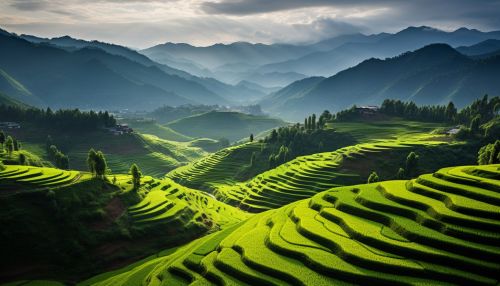Terracing
Introduction
Terracing, in the context of agriculture, is a method of creating flat platforms on the sloping terrain. The process involves cutting steps, often referred to as terraces, into the hillside, which can then be used for various forms of farming. This technique is commonly used in regions where the landscape is hilly or mountainous and traditional farming methods are not feasible. Terracing is an ancient practice, with evidence of its use dating back to prehistoric times in various parts of the world.
History
The history of terracing is as old as agriculture itself. The earliest evidence of terracing can be traced back to the Neolithic period, around 10,000 BCE, when humans first began to practice agriculture. Archaeological evidence suggests that terracing was used in ancient civilizations across the globe, from the Andean mountains of South America to the steep slopes of the Himalayan foothills in Asia.


In the Near East, terracing was used extensively by the Sumerian civilization, who are credited with the invention of irrigation. The terraces they built allowed them to cultivate crops on the arid hillsides of Mesopotamia. Similarly, in ancient China, terracing was a common practice in the hilly regions of the south, where rice was the primary crop. The Rice Terraces of the Philippine Cordilleras, which date back over 2,000 years, are a testament to the ancient practice of terracing in Southeast Asia.
Construction and Design
The construction of terraces involves a series of steps. The first step is to survey the land and determine the best locations for the terraces. This involves assessing the slope of the land, the type of soil, and the availability of water. Once the locations have been determined, the next step is to cut into the hillside to create the terraces. This is typically done using hand tools, such as shovels and pickaxes, although in modern times, machinery may also be used.
The design of the terraces can vary depending on the specific requirements of the land and the crops being grown. In general, the terraces are designed to be as level as possible to prevent water from running off. The width of the terraces can vary, but they are typically wide enough to allow for the planting of crops and the movement of workers and equipment. The walls of the terraces, known as risers, are often reinforced with stones or other materials to prevent erosion.
Benefits and Drawbacks
Terracing offers several benefits, particularly in regions with hilly or mountainous terrain. One of the primary benefits is that it allows for the cultivation of crops on land that would otherwise be unsuitable for farming. By creating flat platforms on the slopes, terracing increases the amount of arable land and can significantly increase crop yields.
In addition to increasing the amount of arable land, terracing also helps to conserve water. The terraces slow down the flow of water, allowing it to seep into the ground and be absorbed by the crops. This can be particularly beneficial in regions with limited rainfall or where water is a scarce resource.
Despite its benefits, terracing also has some drawbacks. The construction of terraces can be labor-intensive and time-consuming, particularly in regions with steep slopes. Additionally, the maintenance of terraces can be challenging, as the walls need to be regularly reinforced to prevent erosion. There is also the risk of landslides, particularly in regions with heavy rainfall.
Modern Applications
In modern times, terracing continues to be used in many parts of the world, particularly in regions with hilly or mountainous terrain. In addition to its traditional use in agriculture, terracing is also used in modern landscaping and urban design. For example, terraced gardens are a common feature in many urban parks and residential landscapes. In urban planning, terracing is often used to create level platforms for the construction of buildings and other structures on sloping land.
